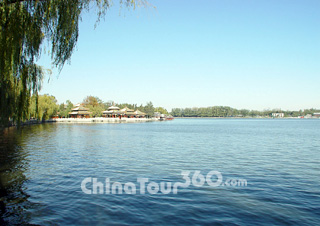 Beautiful Scenery of Beihai Park
Beautiful Scenery of Beihai Park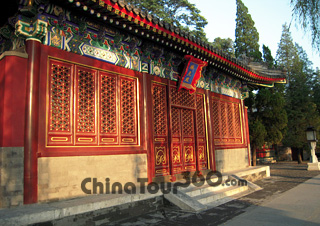 Chengguang Hall, Beihai Park
Chengguang Hall, Beihai Park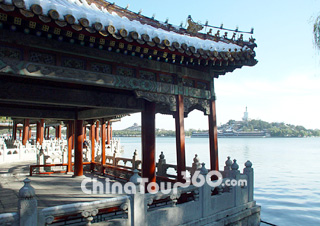 A Pavilion of Beihai Park
A Pavilion of Beihai Park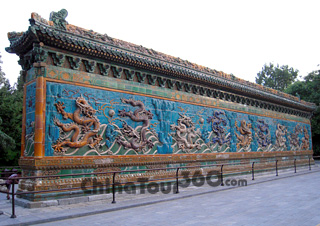 Nine Dragon Wall, Beihai Park
Nine Dragon Wall, Beihai Park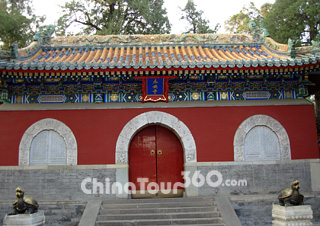 Yong'an Temple, Beihai Park
Yong'an Temple, Beihai Park
Located in the center of Beijing and northwest of the Forbidden City, Beihai Park is an ancient imperial garden with an area of about 71 hectares, half of which are taken up by water. The park obtained its name due to its relative position with Zhonghai (central sea) and Nanhai (south sea). It served as a temporary imperial palace away from the capital in Liao (916 - 1125), Jin (1115 - 1234) and Yuan (1271 - 1368)dynasties and an imperial garden in Ming (1368 - 1644) and Qing (1644 - 1911) dynasties. As a pleasure ground for the imperial family within the Imperial City, Beihai Park was more magnificent and strikingly important.
The Nine-Dragon Screen in Beihai Park is the most eye-catching, for it is one of the three famous screens in China that was constructed in 1756 during the Qing Dynasty. Unlike the ones in the Forbidden City and Datong, Shanxi Province, It boasts of nice huge dragons on both screens with glazed-tiles. It is about 5 meters (5.47 yards) high, 27 meters (29.5 yards) wide and 1.2 meters (1.3 yards) thick. The dragons are depicted flying in a sea of clouds in relief. It's said that there are 633 dragons in total. Two hundred years' exposure fails to make the brightness fade, which implies the greatness and excellence of Chinese artwork in the ancient times.
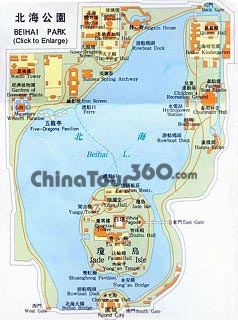 |
| Beihai Park Map |
Situated on top of the Beihai Park, the White Dagoba is a masterpiece of Buddhist art created in the 16th century. A dagoba is actually a single rounded structure topped by a spire and crowned by a golden tip - a gilded ball like a flame, which is different from the multi-storied pagoda in shape. The White Dagoba in Beihai Park is 36 meters (118 feet) high. It is built of brick and stone whitened with lime. It is believed that the lama robes, Buddhist scripture, and the sacred articles are stored inside, and the sutras in Tibetan language are carved inside the front gate. It keeps its mystery because there is no entrance but the red emblem on the body of the tower is the opening which was sealed when completed. Standing on the White Dagoba offers an overall view of the city. Directly south is the Zhongnanhai, to the southeast, the yellow roofs and the vermilion colors of the Forbidden City comes into your eyes.
Inside the park, there are also exquisite pavilions, zigzag verandas and terraces, numerous artificial hills and tunnels. Jade Islet, Beihai Lake, White Pagoda, Nine-Dragon Screen and Circular City all make the visitors breathtaking and memorable.
The layout of Beihai Park embodies the Chinese mythology about the fairyland and achieves an artistic combination of natural and cultural landscape. As an important relic, it brings wonders to all the tourists.
![]() Entrance Fee:
Entrance Fee:
CNY 10 (Apr. 1 to Oct. 31); CNY 5 (Nov. 1 to Mar. 31)
![]() Opening Hours: 06:30 - 21:00
Opening Hours: 06:30 - 21:00
![]() Transportation:
Transportation:
A. Take Bus No. 101, 103, 109, 812, 846 or Kang-En Special Line and get off at the south gate of Baihai Park.
B. Take Bus No. 107, 111, 118, 701 or 823 and get off at the north gate of Baihai Park.
C. Take Bus No. 5 and get off at the east gate of Beihai Park.








